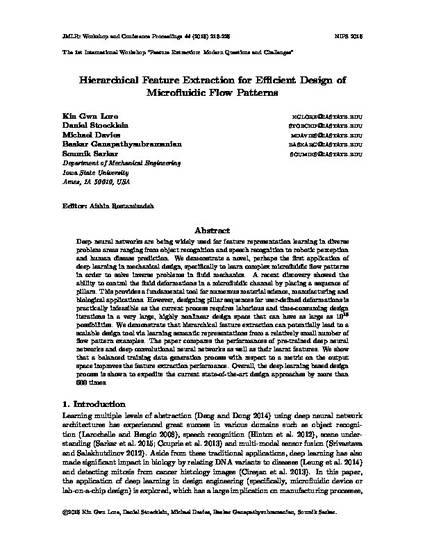
Presentation
Hierarchical Feature Extraction for Efficient Design of Microfluidic Flow Patterns
Proceedings of Machine Learning Research
Document Type
Conference Proceeding
Disciplines
Conference
The 1st International Workshop "Feature Extraction: Modern Questions and Challenges"
Publication Version
Published Version
Publication Date
12-1-2015
Conference Title
Neural Information Processing Systems (NIPS) 2015
Conference Date
December 7-12, 2015
Geolocation
(45.5016889, -73.56725599999999)
Abstract
Deep neural networks are being widely used for feature representation learning in diverse problem areas ranging from object recognition and speech recognition to robotic perception and human disease prediction. We demonstrate a novel, perhaps the first application of deep learning in mechanical design, specifically to learn complex microfluidic flow patterns in order to solve inverse problems in fluid mechanics. A recent discovery showed the ability to control the fluid deformations in a microfluidic channel by placing a sequence of pillars. This provides a fundamental tool for numerous material science, manufacturing and biological applications. However, designing pillar sequences for user-defined deformations is practically infeasible as the current process requires laborious and time-consuming design iterations in a very large, highly nonlinear design space that can have as large as 1015 possibilities. We demonstrate that hierarchical feature extraction can potentially lead to a scalable design tool via learning semantic representations from a relatively small number of flow pattern examples. The paper compares the performances of pre-trained deep neural networks and deep convolutional neural networks as well as their learnt features. We show that a balanced training data generation process with respect to a metric on the output space improves the feature extraction performance. Overall, the deep learning based design process is shown to expedite the current state-of-the-art design approaches by more than 600 times.
Copyright Owner
Kin Gwn Lore, Daniel Stoecklein, Michael Davies, Baskar Ganapathysubramanian, Soumik Sarkar.
Copyright Date
2015
Language
en
File Format
application/pdf
Citation Information
Kin Gwn Lore, Daniel Stoecklein, Michael Davies, Baskar Ganapathysubramanian, et al.. "Hierarchical Feature Extraction for Efficient Design of Microfluidic Flow Patterns" Montreal, Quebec, CAProceedings of Machine Learning Research Vol. 44 (2015) p. 213 - 225 Available at: http://works.bepress.com/baskar-ganapathysubramanian/20/

This proceeding is published as Lore, Kin Gwn, Daniel Stoecklein, Michael Davies, Baskar Ganapathysubramanian, and Soumik Sarkar. "Hierarchical feature extraction for efficient design of microfluidic flow patterns." In Proceedings of The 1st International Workshop on “Feature Extraction: Modern Questions and Challenges”, NIPS 2015, PMLR 44:213-225, 2015. Posted with permission.